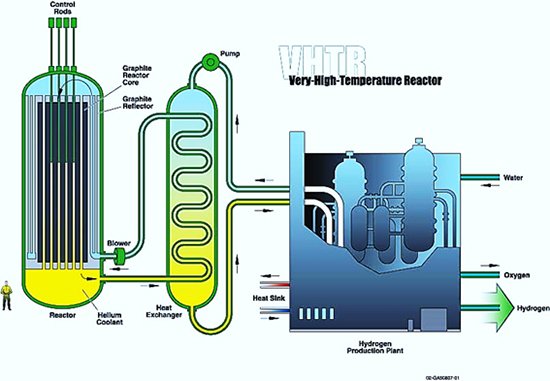
TECHNOLOGY
Generation IV
VHTR ( Very High Temperature Reactor)

Source: "A technology Roadmap for Generation IV Nuclear Energy Systems", U.S. DOE Nuclear Energy Research Advisory Committee and Generation IV International Forum, 12.2002, http://www.gen-4.org/PDFs/GenIVRoadmap.pdf [55]
VHTR is graphite moderated and helium cooled reactor. Moderator presence indicates that it is thermal neutron system. Today concept describes the reference construction with power of 600 MWt (limited by possibilities of passive decay heat removal) and two possible core types. The pebble bed type such as the HTR-PM core has or the prismatic block type, similar to GTMHR core design. HTR-PM and GTMHR are designs being developed nowadays and they belong to generation III+ reactors. HTR-PM has been described here . VHTR directly derives from today generation and it can benefit from developments over core types and generally over high temperature nuclear power plants. Fig. 19 is showing prismatic block core type. VHTR schematic diagram is showing indirect energy conversion to electricity. But it is possible to use direct cycle without heat exchanger on purpose electricity generation. This solution needs development in area of helium gas turbine. However heat exchanger is indispensable to heat generation for industrial use. Very important VHTR feature is core outlet temperature at level of 1000ºC. Such high temperature brings variety of possible heat usage. The most important is hydrogen generation, that can be taken up with high efficiency. Generally VHTR concept is dedicated to such cogeneration and it may be serious impact for faster deployment. Operating at very high temperature causes increase in thermal efficiency. It goals 50% with fuel burn-up 150-200 GWd/t. Fuel cycle is going to be once-through. VHTR does not offer good wastes management. Nevertheless development leads to possibility of closed fuel cycle adopting in the future. It is also possible to symbiotic use of two power plants, one very efficient and heat generating, second able to wastes burning. The design requires significant R&D not only in turbine technology but also in fuel performance and material's high temperature resistance. All in all the VHTR is aimed to hydrogen production and industrial heat generation, even though it is high efficient in electricity generation. The VHTR is planned to be commercialised until 2020. [50],[51],[52],[54],[55],[56],[57],[58],[59]


-
Nuclear power industry|
Technology|
The electricity supply system aspect|
Economics|
Environment|
Public aspect|
Future|
Legislation|
References|